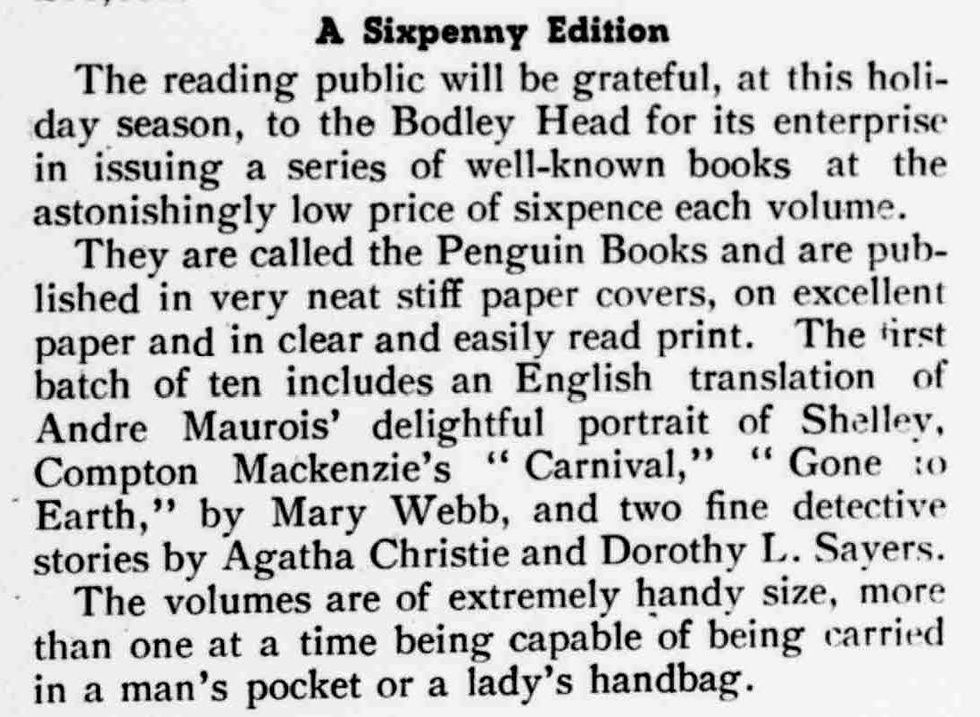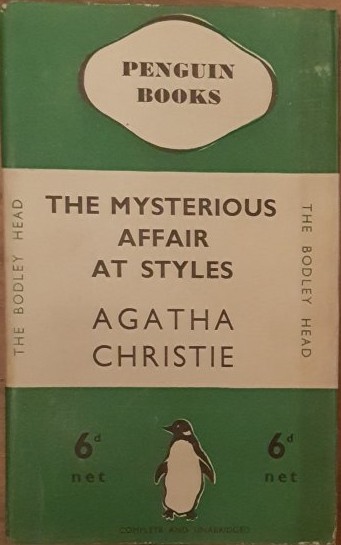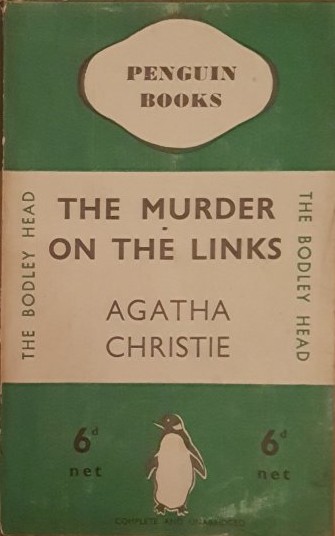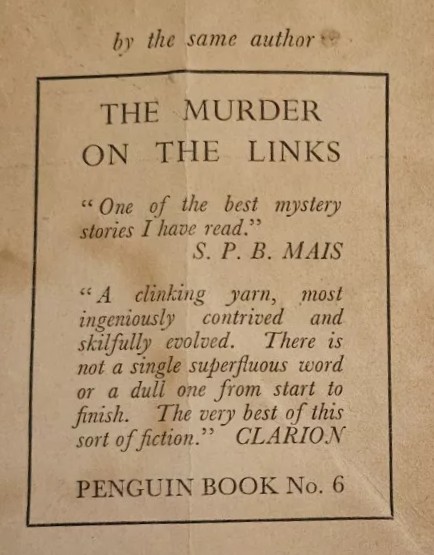Penguin Books & Agatha Christie
- David Morris
- 11 hours ago
- 15 min read
Introduction.
Among the various publishers that have brought Agatha Christie’s works to the public, Penguin Books is certainly a significant one. This article explores the connection between Agatha Christie and Penguin Books, discussing how their collaboration increased the accessibility and popularity of Christie's novels primarily in years from 1935 to 1975.
Penguin Books.
Founded in 1935 by Allen Lane, Penguin Books had a goal to revolutionize the publishing industry by making high-quality literature affordable and accessible. It is claimed that the idea for Penguin came to Allen Lane while he was waiting for a train and couldn't find anything engaging to read. We have Devon to thank for Agatha Christie and we also can thank Christie & Devon for Penguin Books. According to Penguin Books, in 1934 Lane had spent the weekend with Agatha Christie at Ashfield in Torquay and was journeying home. While waiting at St. Davids Station in Exeter he stopped at the station bookstall and saw that the books on sale were of a poor quality and overpriced. What was needed, he realised, were good books at a price everyone could afford t! He envisioned a series of books that were not only inexpensive but also well-designed and widely available. Penguin’s immediate focus was not solely on the paperback format but also on printing titles people wanted to read at a fraction of the cost of hardcovers. This democratization of literature, often referred to as Penguinization, opened a world of possibilities for both readers and authors.
Penguin & The Bodley Head.
Lane’s family was already experienced in bookselling. He was one of three brothers – the others were Richard and John. They were the nephews of the original John Lane who is likely already a recognizable name to collectors of Christie as he published Christie’s first novel both in the UK and US under his imprint ‘John Lane, The Bodley Head’. They went on to publish Christie’s first six books in the UK.
When Allen came up with the idea for Penguin Books, he was the Managing Director of The Bodley Head. While his brothers and the Board at The Bodley Head did not support the project, they let Allen use their offices and their imprint to launch the business. This is why the first eighty Penguins (through January 1937) reference The Bodley Head on the front cover, and the earliest ones also on the rear cover. As seen in the trade publication, The Bookseller, the launch of Penguin was under the headline 'Bodley Head To Issue Sixpenny Series'.

Strong sales made it clear Penguin would be successful, while The Bodley Head was struggling with its hardback book business. Reviews in the press were also positive. The example below is from August 10, 1935 as seen in London's The Saturday Review.

With the imprints success, in January 1936 the three brothers spun off the entity as ‘Penguin Books Ltd.’ Allen soon resigned as Managing Director of The Bodley Head to focus exclusively on Penguin.
Cost Management.
One way the cost was controlled was through the use of the ‘8 crown perfecter’ printing machine. This machine printed on sheets of paper that were five feet long by three feet wide. Each sheet contained 32 pages which meant that every Penguin needed to be published in multiples of 32, such as 256, 288 or 320 pages. If the book didn’t fit neatly to that length, it was not abridged but marketing pages were added to fill up most of the blanks. Their decision not to abridge, as many other low cost paperback publishers did, was boldly shared on the front of each book by stating 'Complete - Unabridged'. The resulting size was a paperback 7 1/8” x 4 3/8”, smaller than the earlier paperbacks from Collins in the 1930s. The ratio was now almost 8 to 5, considered the ‘Golden Section’ or ‘Golden Ratio’ of classical art & architecture that is deemed aesthetically pleasing.
Another way costs were controlled was by having a simple cover design generally of two bold colour blocks – white and green for the Crime & Mystery genre which included Christie – plus black text.
Even the logo was designed in-house from sketches of penguins made at London Zoo and initially was the only artwork on the cover. Over the years, the design of the Penguin shifted slightly which is a good visual reference to help identify the timeframe the book was published in. Below are the Penguin's from 1935 - 1949. Some have suggested the 1938-1948 Penguin is suffering from appendicitis.

The war caused further changes to control costs and paper consumption. The most noticeable change was the end of dust jackets as of January 1942. Any Penguin issued prior to this would have originally had a jacket, though they are exceptionally scarce to find in any condition, let alone intact.
It is worth noting that The Albatross, a European imprint for Collins' Crime Club, began operations in 1933 - two years prior to Penguin. They also had a sea-bird as their namesake and logo, a simple design, and a jacketed stiff board paperback format. Undoubtedly, Allen Lane was influenced by The Albatross in both the naming and design aesthetics for Penguin.
To learn more about The Albatross see my article at this link.
Penguin’s Initial Launch & First 21 Years.
The first ten Penguin titles were released together in August 1935, and they included works by Ernest Hemingway and André Maurois, as well as one by Agatha Christie. Each title was numbered, 1 through 10, with Christie’s The Mysterious Affair at Styles slotting in at number 6.
In October 1935, a further 10 titles were published, bringing the total released in 1935 to 20 titles. In both 1936 and 1937, fifty more titles were added each year. However, across the first 21 years in operation a total of 1,169 Penguin titles were published, an average of 55 per year.
Beyond the regular Penguin titles, the publisher expanded into many other genres under the Penguin brand, such as Penguin Classics, Penguin Poets and Penguin Shakespeare – just to name a few. Additional brands appeared too – each theme beginning with the letter P such as Puffin, Ptarmigan and Porpoise. Pigeon was a bird option if they wanted another, but it clearly was not chosen!
During the first 21 years a total of 22 Agatha Christie titles were published. In later years a further six titles were added - the last in 1975 - bringing the total to twenty-eight. The affordability and portability of paperbacks meant that the authors they published, including Christie, could be enjoyed by a wider demographic, including those who might not have been able to afford hardcover editions. This move significantly expanded her readership and solidified her status as a household name.
The Penguin Christies.
1935.
No. 6: The Mysterious Affair at Styles. Published on July 30th as one of the original ten books released by Penguin. It is estimated that only 10,000 copies of this title were bound for sale. It was reprinted twice in 1935 likely in a larger-size print run (I’ll speculate 20,000 each), first in August 1935 and then in September 1935. It was then pulled from reprints as Penguin was not certain they had the publication rights to the novel. Thus, there were probably only around 50,000 copies in total of this title produced as No. 6, of which there are likely very few remaining in collector quality condition.
Identification Tips: One easy way to quickly identify these initial printings is how the book’s title was printed on the cover. In 1935, the title was printed across three lines as ‘THE MYSTERIOUS / AFFAIR / AT STYLES (Image of front cover below left and rear cover in centre). When it was reprinted at No. 61 (see below right), the title was printed as ‘THE MYSTERIOUS / AFFAIR AT / STYLES.
If you see an image of the book where the cover has ‘6d net’ printed on both the lower left and lower right of the front cover, then you can immediately tell that the dust jacket is still present (see image earlier in this article). This pricing placement was only on the jackets, not on the book itself. This is true for 6A and 61 below also as these are the only three Christies that were shod in jackets.
1936.
In 1936 Penguin reportedly sold 3 million copies in total. With 50 titles, this averages 60,000 per title and, if you assume each title on average was published twice in a year, it gives a sense of the size of each print run being around 30,000.
No. 6A: The Murder on the Links. Published on March 27th and numbered 6A to replace 6 given the uncertainty around publication rights discussed above.
In future reprints, it was just numbered 6, not 6A, as seen above in an advertisement for the title inside the No. 61 reprint of Styles.
In the press, Penguin didn't reference their confusion regarding printing rights. How they chose to handle this is seen in the January 1936 issue of Bookseller magazine distributed to the trade. They state that it would be their policy to 'drop certain titles from time to time' (see clipping below).

No. 61: The Mysterious Affair at Styles. Re-published on July 29th, a year after its initial premature release as Penguin was now certain they had the publication rights. The book was now numbered 61 since The Murder on the Links had taken over the number 6 spot. It was reprinted two more times in 1936, in August and December. As with most titles, it was then consistently reprinted in the years following.
It is worth noting that no new Christie titles were published during the war years. Penguin’s published during those years, and especially 1942-1945, are generally scarcer and more valuable that those that came prior to or after the war. However, Penguin did reprint No. 6 and 61 during that period in the UK, and even in Australia . These wartime reprints generally are easily identified by the use of advertisements on the rear panel (UK on left, Australia on right).
1948.
The following ten titles were all released in August 1948 with a print run of 100,000 per title. This likely was a record for Christie since 1,000,000 books were all published simultaneously. Each book was priced at 'One shilling and sixpence' on the front cover (now without jackets).
No. 682: Appointment with Death. As you can see from the images below, the rear panel on the first printings in 1948 had a photograph of Christie and a brief biography. When these titles from 1948 were reprinted in 1949, a newer photograph by Morgan was used (below right). I expect Christie or her agents were not thrilled with the more vintage photo used on the initial printing. This visual cue (the photograph by Black) is a quick way to ensure you are acquiring a first printing.
No. 683: The A.B.C. Murders.
No. 684: The Murder of Roger Ackroyd.
No. 685: Lord Edgware Dies.
No. 686: The Murder at the Vicarage.
No. 687: The Seven Dials Mystery.
No. 688: Peril at End House.
No. 689: Murder on the Orient Express.
No. 690: The Sittaford Mystery.
No. 691: The Mystery of the Blue Train.
1953.
The following nine titles were all released in May 1953. Why ten new titles were not published in unclear, but Penguin did reissue No. 684 (The Murder of Roger Ackroyd) with this batch to again give Christie at least a 1,000,000 copy print run. The books were now priced 2/- net in black on the bottom right front corner. The rear panel photo was again updated - now with the portrait by Angus McBean. Reprints from the late 1950s will show a price of 2/6.
No. 924: The Body in the Library.
No. 925: Crooked House. Note: This is the first British paperback of this title. Globally, it was preceded by the Canadian Collins White Circle paperback, No. 478 (1950).
No. 926: Death Comes as the End.
No. 927: Death on the Nile.
No. 928: The Labours of Hercules. Note: This is the first British paperback of this title. Globally, it was preceded by the American Dell ‘map-back’ paperback, No. 491 (1951).
No. 929: Miss Marple and the Thirteen Problems. It is worth noting that Penguin enhanced the title with the addition of Miss Marple’s name as the original book was solely titled The Thirteen Problems. The rationale for the addition is unclear as by now Christie’s name was usually adequate to sell a book.
No. 930: The Moving Finger.
No. 931: The Mysterious Mr. Quin.
No. 932: Parker Pyne Investigates.
1955.
No. 1099: Murder in Mesopotamia. Printed in July and priced 2/6. This cover is rather unique as it includes the Collins Crime Club logo of a hooded gunman on the left-hand side, with green vertical stripes rather than horizontal bars (which it reverted to on the 1959 reprint). This title was one of ten that were published simultaneously by Penguin in 1955 to celebrate the 25th Anniversary of Collins’ Crime Club. Other authors included in the tribute printing included Ngaio Marsh, Rex Stout and Nicholas Blake.
Those listed above are all the Christie titles published during Penguin’s first 21 years in business and are discussed in their paperback The Penguin Story, published in July 1956 (and apparently the only unnumbered Penguin!).
This is an excellent book for Penguin collectors as it lists all the titles and numbers during that period though does not reference the snafu over 6 and 6A.
1957-1961 & the Abrams Covers.
[Reprint] No. 1099: Murder in Mesopotamia. Published in 1957, this is a reprint worth discussing as it had a unique artistic cover created by Stanley Godsell. These covers are commonly referred to as ‘Games covers’ after Abram Games who was hired to oversee the creation of artistic covers. It was a short-lived experiment as Penguin only published 33 books with these ‘Games’ covers over a 10-month period starting in April 1957 of which some were reprints and some were first printings. Games designed 7 of the covers while ten other artists, such as Godsell, were commissioned to create the other covers. The rear layout was also updated, providing a refreshed look. Only two Agatha Christie books were published as part of this ‘test’. The other is Murder is Easy – discussed below.
No. 1195: Murder is Easy. Printed on June 27, 1957. Priced 2/6. This book is also unique as it was also issued with an illustrated cover by Stanley Godsell. But in this case it is a first printing of this title by Penguin. Consequently, these two books are some of the more collectible Christie paperbacks. For those interested in learning more about the Games covers, I recommend the book Abram Games and Penguin Books written by his daughter, Naomi Games.
The Final Penguins.
Only three more Christie titles were published by Penguin during the fifties and sixties, with a further two in the 1970s. I expect that Penguin was losing access to Christie titles due to the success of Collins’ own paperback division – Fontana. While Fontana was launched in 1953, by the late 1950s they had become a successful imprint and were slowly working their way through the Christie catalogue.
No. 1196: The Big Four. First published July 25, 1957. The cover design had now reverted to the traditional green and white horizontal bars.
No. 1256: And Then There Were None. Published under the original UK title TLN. First published on January 9, 1958. On the inside of the front cover, reference is made to the filming of this novel shortly after its initial publication.
No. 1637: Murder in the Mews and Other Stories. First published on July 27, 1961. This book’s cover featured a redesigned layout. There were still green and white horizontal stripes but the Penguin Books cartouche and logo were now offset to the right which started in early 1960. While the prior two books continued to have Christie's photo on the rear panel. this book did not.
[Reprint] No. 1637: Murder in the Mews and Other Stories. Another reprint worth discussing as this title was reprinted in 1962 with a rather odd photographic cover. Its design is very similar to No. 1664 – Through a Glass Darkly by Helen McCloy. This was clearly a period of time when Penguin was experimenting with different design concepts. It is the only Christie with this design style.
The End of Penguin Crime.
In 1970 Allen Lane died and Penguin was acquired by Pearson PLC. For many collectors this marks the end of the Penguin’s heyday. It is also the beginning of ISBN numbering which changed how books were numbered - another event that marks a shift in the appeal of the books for collectors as the spine based numbering ended.
Rather oddly, Penguin published two new Agatha Christie titles in the 1970s that featured both the Penguin logo and the Penguin Crime branding. Given Fontana’s success with Christie it is unclear why rights were given to Penguin to publish these books. The series numbers for the two books below were extracted from their ISBN numbers. The cover designs are certainly questionable but continue the evolution that began with the reprint of The Murder in the Mews.
No. 3804: The Mirror Crack’d From Side to Side. First published in 1973.
No. 4213: Towards Zero. First published in 1975.
Last, but not least, in 1985 Penguin reissued the original 1935 No. 6 The Mysterious Affair at Styles as a 50th anniversary facsimile (along with the other titles 1-10). While no jacket was recreated the book almost matches the first printing - front and rear. They failed to recreate the original title layout, but in error used the No. 61 layout. Inside, the only change is on the copyright page where it states it is a special reprint edition. For me, this printing marks the end of the Penguin era as to my knowledge since then no other Agatha Christie book has been printed by Penguin that bears the Penguin logo or Penguin Crime branding.
Thus, this fifty-year window really captures the core of this relationship between Christie and a publishing giant.
Other Insights.
Christie's Penguin books were not sold in the USA or Canada - something that was often printed on the books. They were available in much of the Commonwealth though. In Australia, Penguin Books were based in Mitcham (on the outskirts of Melbourne), Victoria. In New Zealand, they were based in Auckland. I’ve also seen books that were sold in South Africa with a different price sticker affixed. However, in most cases the Penguins sold overseas were printed in the UK, even if they referenced the regional office on the copyright page. This changed during the war as I am aware that in 1945 the Lothian Printing Company in Australia did print a Penguin edition of Christie’s The Murder on the Links with the notation that this is the first Australian printing.

Values.
The scarcest and most valuable printings are the original 6, 6a, and 61 (in that order). For No. 6, all of the initial three printings are collectible and likely valued as follows (for Very Good copies):
No. 6, 1st printing. In jacket: £800 ($1,100). Without jacket: £300 ($400).
No. 6, 2nd printing. In jacket: £650 ($850). Without jacket: £150 ($200).
No. 6, 3rd printing. In jacket: £600 ($800). Without jacket: £100 ($130).
(note: I am valuing a 'very good' jacket at £500 regardless of edition and I expect any jacket found on a 2nd or 3rd printing will quickly be married onto a 1st printing).
No 6A, 1st printing. In jacket: £600 ($800). Without jacket: £200 ($260).
No. 61, 1st printing. In jacket: £500 ($650). Without jacket: £100 ($130).
Of note, a copy of the Australian 1945 printing of 6A recently sold for £50 ($65).
The books published in 1948 were 100,000 print runs and it is likely the later ones were also, if not more. Most of these books are certainly less scarce and easier to find in collector quality condition. Values for these titles are mostly £25 ($30) when in very good condition. There are some exceptions. Expect to pay more for No. 684 as it is one of Christie’s most appealing titles. A recent collector quality copy sold for £50 ($65).
The books published in 1953 generally sell for £20-25 ($25-30) each when in very good condition, with a couple of exceptions. For No. 925 and No. 928, as they are first British paperback editions, the fair value is around £35-40 ($45-50) each. No. 1099, given it was part of the Crime Club special tie-in, is also worth more – perhaps £30-35 ($40-45). The Games editions are also a little more collectible and fairly valued at £25 ($35) each. Lastly, No. 1256 (TLN) garners a higher value as it is one of her most sought-after titles and can reach £100 ($130) for a very good copy of the first printing. Generally, any reprint of these later books will just sell for used book pricing.
Other Research Sites.
For those looking to learn even more about Penguin Books in general, I recommend the following:
PenguinFirstEditions.com – an excellent resource with information on all the Penguins published, plus much more.
Jules Burt’s YouTube channel – a noted collector of paperbacks but especially Penguins.
Penguin.co.uk – The official Penguin website with both current and historical insights.
Other News: The 2025 International Agatha Christie Festival.
I am pleased share that I will be presenting at the 2025 International Agatha Christie Festival. It is a week long festival in Torquay, Devon that is well worth attending. I will be part of a wonderful evening (Thursday 18th Sept) celebrating the artwork of Tom Adams, creator of numerous iconic Agatha Christie book covers. The event begins with an illustrated talk I'm preparing. My talk is titled 'Tom Adams: The Art of the Artist' and in it I'll share exclusive insights into the creative genius of Tom Adams based on my research in his archives. Following my presentation, attendees are invited to the adjacent Torre Abbey Museum for a drinks reception that celebrates the launch of a new and related exhibit 'Tom Adams and Agatha Christie: Partners in Crime' where you will have exclusive access to view the exhibition before its opening to the public on Friday 19th September. More details and tickets can be found at: https://www.iacf-uk.org/festival-2025/literary/tom-adams-and-agatha-christie-partners-in-crime
Subscribe & the Socials.
If you are not a subscriber to my website, please consider subscribing here: link. This ensures you receive an email any time I write and post an article. Re: Social Media accounts - do consider following me on X (formerly Twitter) @collectchristie , on BlueSky @collectchristie.bsky.social and on Facebook. The content on X and BlueSky is identical, but will vary on Facebook. All should be of interest for any fan of Agatha Christie.
Feedback.
As I usually do, I've likely missed a few things or made a few errors - so do get in contact with me if there's an improvement to be made to this article. I view all my articles as collaborative efforts and want them to be an accurate resource for collectors. I have lots more articles I'm working on but if there's something you'd like me to consider do let me know by writing to me at: collectchristie@gmail.com
Happy Collecting.












































































































Love the illustration of all the Penguin logos!